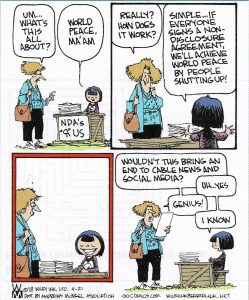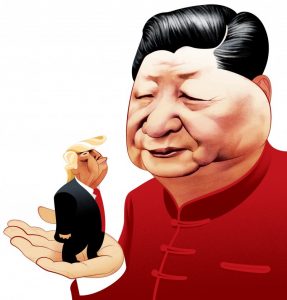In a desperate attempt to escape the gravity of the Trump-news broadcasting conglomerate, mariner has traveled to distant lands – a part of the planet where Donald is a sideshow. As a straightforward example, note this book review covered in a British news outlet:
“In it Rory Medcalf, Head of the National Security College at the Australian National University, highlights an emerging formation on the geopolitical map: the Indo-Pacific, a growing web of alliances centered on the “Quad” of India, Japan, Australia and the US, but also taking in a crescent of maritime states in eastern, south-eastern and southern Asia. Looser and more multipolar than other such formations, it is unified by the quest to balance, dilute and absorb Chinese power. “The Indo-Pacific is both a region and an idea: a metaphor for collective action, self-help combined with mutual help,” writes Medcalf. Two months on from its publication, virtually all of the trends that his book draws together have advanced.”[1]
![]() North America not only has a shoreline on the Pacific, it has been drawn into Pacific Rim activity since the explorer Jorge Álvares reached southern China in 1513.[2] The US involvement in Asia is dominated by wars. Consider: The Korean Expedition 1871, acquisition of Samoa 1898, Spanish American War 1898 and 1913, Boxer Rebellion 1898, World War I 1917, World War II 1939, Korean War 1950, Laotian Civil War 1953, Viet Nam War 1955, 1965, 1974, Communist insurgency in Thailand 1965 and Cambodian Civil War 1967.
North America not only has a shoreline on the Pacific, it has been drawn into Pacific Rim activity since the explorer Jorge Álvares reached southern China in 1513.[2] The US involvement in Asia is dominated by wars. Consider: The Korean Expedition 1871, acquisition of Samoa 1898, Spanish American War 1898 and 1913, Boxer Rebellion 1898, World War I 1917, World War II 1939, Korean War 1950, Laotian Civil War 1953, Viet Nam War 1955, 1965, 1974, Communist insurgency in Thailand 1965 and Cambodian Civil War 1967.
As Medcalf points out in his book, things have changed. In the part of the world fronted on the Pacific Rim, China has grown to be a super power in the midst of many smaller nations that easily can be dominated by China. The reader may recall an effort in 2016 called the Trans-Pacific Partnership (TPP). Twelve nations signed on but the agreement failed to be ratified by the US. The countries were Australia, Brunei, Canada, Chile, Japan, Malaysia, Mexico, New Zealand, Peru, Singapore, Vietnam, and the United States.
The TPP concept of an international trade agreement that assigned an economic role to each nation up front was a new turn in international relationships that heretofore were variable agreements subject to tariffs, internal politics and market activity. Still, many criticized the agreement for allowing business interests to ignore or supersede traditional national rights.
Americans are not accustomed to paying attention to India. However, India is a fellow ‘sumo giant’ along with China[3]. Together, India and China represent thirty-six percent of the world’s population; of every three humans on earth, one of them is an Indian or a Chinaman.
The United States ranks third in land mass and population, but ranks first in GDP at 21.44 trillion. China is second at 14.14 trillion and India is fifth with 2.94 trillion but has the fastest growing GDP in the world.
Mariner hopes his data profile may invite readers to invest time and interest in a part of the world that truly will dominate future centuries regardless of treaties. Already it can be seen that Europe and the Middle East will not have the clout to compete with the Sumo League. For the first time, the center of world civilization may be the Pacific Rim.
In any case, mariner had a great time visiting the ‘other’ world. Donald who?
Ancient Mariner
[1] Indo-Pacific Empire, China, America and the Conquest for the World’s Pivotal Region by Rory Medcalf, Manchester University Press ISBN: 978-1-5261-5078-3
[2] An interesting side note, a Chinese adventurer named Hwui Shan crossed the Pacific to Mexico in 458 AD.
[3] In 2018, population of China is 41 million more than India. Due to higher population growth of India, margin between these two countries is coming down quickly. And in 2024, India will have more people than China with approximately 1.44 billion people.


 pandemic. The virus has provided a rationale for expanding the surveillance state and introducing even stronger political control. Instead of wasting the crisis, Xi is using it to expand the country’s influence. China is inserting itself in place of the EU by assisting distressed national governments, such as Italy. Many of the masks and testing kits it has supplied have proved to be faulty, but the fact seems not to have dented Beijing’s propaganda campaign.
pandemic. The virus has provided a rationale for expanding the surveillance state and introducing even stronger political control. Instead of wasting the crisis, Xi is using it to expand the country’s influence. China is inserting itself in place of the EU by assisting distressed national governments, such as Italy. Many of the masks and testing kits it has supplied have proved to be faulty, but the fact seems not to have dented Beijing’s propaganda campaign.